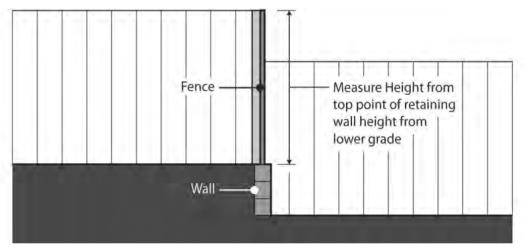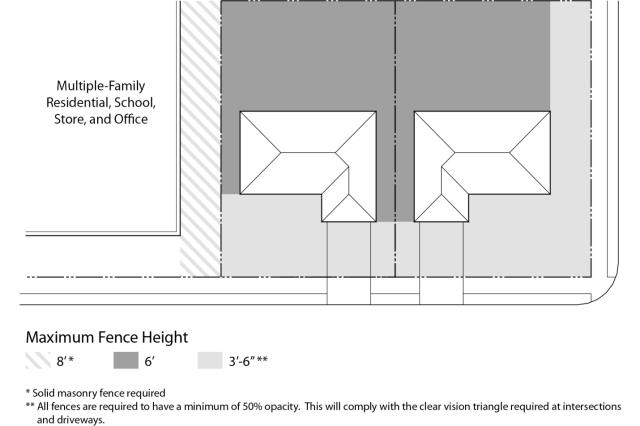Chapter 18.70
FENCES, WALLS, AND SCREENING
Sections:
18.70.030 Measurement of fence, hedge, and wall height.
18.70.040 Height, setback, and permeability requirement.
18.70.050 Design and materials.
18.70.010 Purpose.
The purpose of this chapter is to establish development standards and regulations for fences and walls. The intent of these regulations is to provide for adequate air and light permeability onto lots, for adequate buffering between and screening of uses and activities, and for the mitigation of noise. (Ord. 738 § 1 (Exh. A) (part), 2013).
18.70.020 Applicability.
All fences, walls, and screening shall be constructed according to the requirements of this chapter, except where exempt.
A. Exemptions.
1. Fences that are required by federal or state law or regulation, or which are required by the city for public safety (e.g., temporary construction site fencing) are exempt from this section.
2. Walls that are required by a mitigation measure and designed and approved through a tentative subdivision map, tentative parcel map, or site plan and architecture review for noise attenuation are exempt from this section. (Ord. 738 § 1 (Exh. A) (part), 2013).
18.70.025 Permit required.
A. No fence or wall shall be installed or constructed unless a fence permit is first obtained in compliance with Division II (Procedures), Section 18.16.080, or if the fence is exempt as outlined in Section 18.70.020.
B. Fences and Fence Changes Without a Fence Permit. The following are permitted without a fence permit; provided, that they comply with the provisions of this chapter, and any required building permit is obtained:
1. Repair of existing fences or walls. (Ord. 848, 2020).
18.70.030 Measurement of fence, hedge, and wall height.
A. Fence, hedge, and wall height shall be measured as the vertical distance between the lowest finished grade at the base of the fence and the top edge of the fence material. The finished grade shall be that as shown on the approved grading plan for the site at the time of initial development of the residential subdivision, multifamily development, or nonresidential development. In cases where a retaining wall does not require the approval of a grading plan, the finished grade shall be as determined by the public works director.
B. Landscape Walls. When a fence or wall is placed atop a landscape wall (as defined in this title), the height of the landscape wall shall be considered as part of the fence or wall for purposes of determining the height of the fence or wall.
C. Retaining Walls. When a fence or wall is placed atop a retaining wall, the height shall be measured from the bottom of the retaining wall (see Figure 18.70.030-1).
Figure 18.70.030-1 Measurement of Fence and Wall Height
(Ord. 738 § 1 (Exh. A) (part), 2013).
18.70.040 Height, setback, and permeability requirement.
A. Setback, height and permeability standards for fences, hedges, and walls are provided in Table 18.70.040-1.
|
Location of Fence, Hedge, or Wall |
Maximum Height |
|---|---|
|
Front setback |
3'-6"1 |
|
Exterior side yard setback |
6'2, 3 |
|
Rear or interior side setback |
6'/8'0"3 |
|
Within the vision triangle |
36" |
1. Fencing in the front setback is required to be a minimum of fifty percent open view (fifty percent opacity).
2. Fences located in residentially zoned areas may extend an additional one foot in height if topped with a decorative lattice to match the fence material.
3. Fences may be permitted up to eight feet in height in the HI district, and up to ten feet with the issuance of a conditional use permit from the planning commission (building permit is also required).
B. Landscape Walls. Landscape walls (e.g., decorative masonry, stone, and other materials) within required yard areas shall be constructed to a maximum height of thirty-six inches. Landscape walls shall not be used as retaining walls to alter the finish grade of the lot.
C. Retaining Walls.
1. Timing of Construction. Retaining walls shall only be constructed as part of an approved grading plan for the site at the time of initial development of the residential subdivision, multifamily development, or nonresidential development, as part of a roadway improvement project, or as part of the necessary stabilization of the soil for the primary intended use of the property as determined by the public works director.
2. Height Limit. The height of retaining walls shall be limited to that height reasonably necessary to support and retain the soil for the property.
D. Residential Buffer.
1. When any multiple-family residential dwelling greater than five units abuts a single-family residential dwelling, an eight-foot-high solid masonry wall shall be required unless the planning commission approves an alternative upon architectural and site plan approval.
2. Whenever new construction of any residential use abuts any educational institution, child care facility (with the exception of home-based child care), day nursery, small group care facility, nursing facility, convalescent facility, public utility substation, or any commercial, industrial, medical/professional office, or public/quasi-public use and/or district, an eight-foot-high solid masonry wall shall be required unless the planning commission approves an alternative upon architectural and site plan review.
Figure 18.70.040-1. Height Limits for Fences, Hedges, and Walls
(Ord. 848, 2020; Ord. 738 § 1 (Exh. A) (part), 2013).
18.70.050 Design and materials.
A. Open View Fencing. Where fencing is proposed along public frontages of nonresidential and multifamily projects, such fencing shall be open view (a minimum of fifty percent open view) unless otherwise required to be solid for noise attenuation. Open view fencing shall also be required when located adjacent to open space areas.
B. Fencing Materials. Fences and walls shall be constructed of long-lasting materials. The following standards apply:
1. The use of chain-link fencing is prohibited in all residential, commercial, and PQP districts unless planning commission approval is obtained upon architectural and site plan review. Chain-link fencing may be permitted in commercial districts if not visible to the public with slating.
2. Unless approved as a condition of approval or in conjunction with another planning permit or entitlement, fences or walls of sheet or corrugated iron, steel, concertina wire, or aluminum are prohibited, with the exception of ornamental fences.
3. A minimum of No. 2 grade wood is required for all wood fences constructed.
4. Where permitted, chain-link fencing shall incorporate slats (vinyl slats preferred) for all commercial districts, unless otherwise approved during architectural and site plan review or conditional use permit review.
5. Barbed wire fencing shall not be constructed or placed on top of a fence except as permitted by the planning director as part of the administrative review process and only in industrial areas not abutting residential or commercial areas.
C. Graffiti-Resistant Surface. When required by the city or through conditions of approval due to the location and nature of the wall, masonry walls shall be treated with a graffiti-resistant aesthetic surface.
D. Landscaping. All required street side yard areas between the back of sidewalk and fence/retaining wall shall be landscaped. Climbing vines shall be planted to grow on walls to deter graffiti. (Ord. 738 § 1 (Exh. A) (part), 2013).
18.70.060 Maintenance.
A. All on-site landscaping shall be kept in a well-maintained and presentable manner which makes a positive contribution to the surrounding area.
B. Fences and walls shall be maintained at all times (e.g., broken slats replaced). (Ord. 738 § 1 (Exh. A) (part), 2013).
18.70.070 Exceptions.
A. Fire Hazards. The building official shall not grant a building permit for the erection of any fence which will interfere with access in case of fire to buildings in the vicinity or which will constitute a hazard to street traffic or to pedestrians.
B. Temporary Fences. Nothing in this title shall be deemed to prohibit the erection of temporary fences around construction works erected or maintained pursuant to the building codes and other laws of the city. (Ord. 738 § 1 (Exh. A) (part), 2013).


